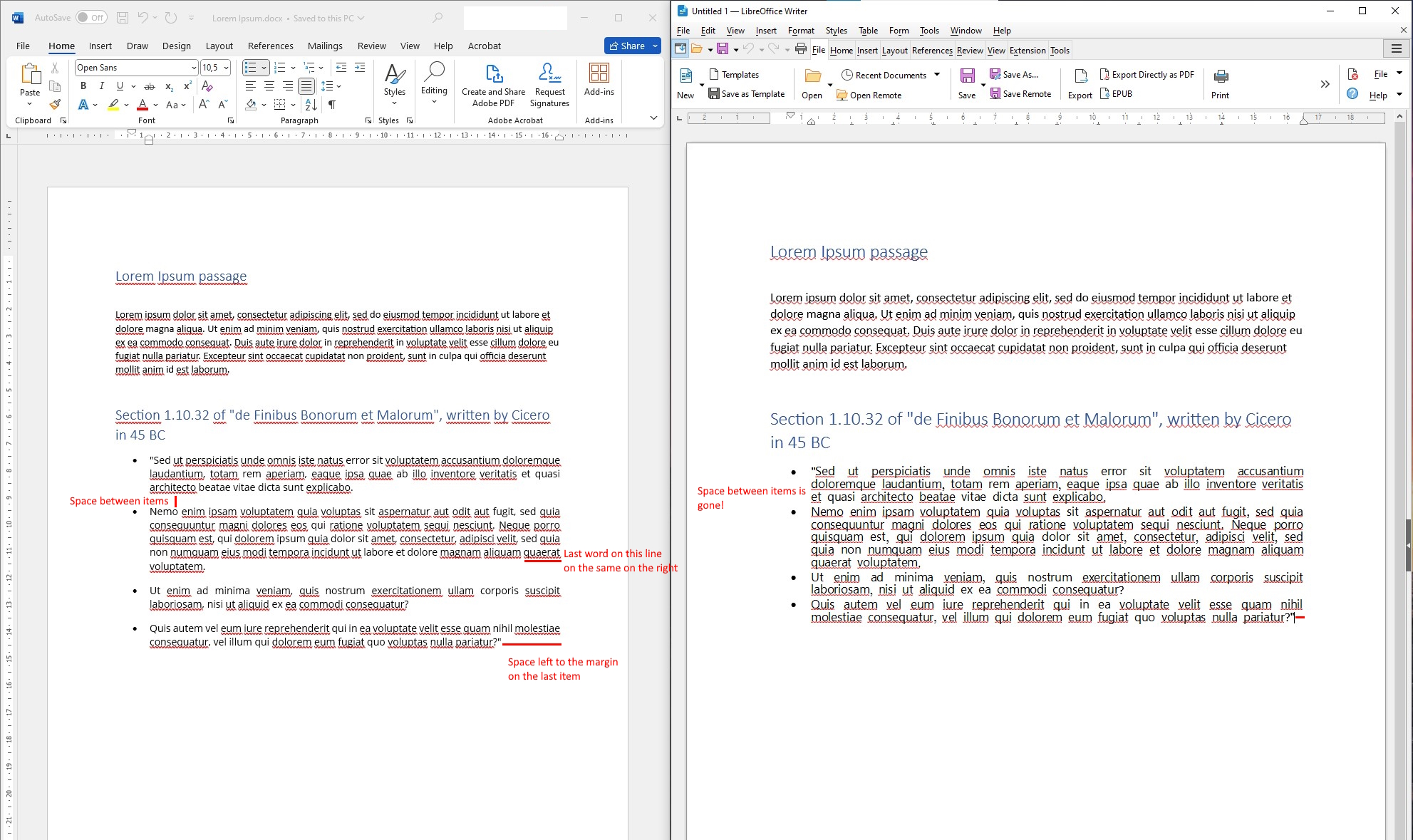In the end of November 2022 (1 year ago), I switched from MacOs to Linux (Debian with KDE Plasma) on my MacBook.
No regret! Was a very good decision.
I think, I’ll never go back.
Experience:
- I did not know about KDE Plasma until 1 year ago. The picture in my head about Linux was pretty much GNOME. I’m a huge fan of KDE Plasma now. KDE Plasma 6 in 2024 will probably be awesome.
- The GitHub repository “Awesome-Linux-Software” was awesome during the first weeks. It made me realize that most of the stuff I was already using, is also available for Linux. Only software I had to leave behind: Affinity Designer (IMO far more intuitive to use than GIMP, sorry FOSS community) and Visual Studio for Mac (which is dead anyway)
- The only advanced thing I had to do in the beginning: My WIFI connection is always gone when I close my MacBook, but there is not automatic reconnect when I reopen it. None of the usual stuff recommended when using Debian on a MacBook helped. So, I had to write a service that checks for this (something with rmmod, modprobe, brcmfmac, …). Probably too much for a casual user and hopefully not necessary for them…
TODO in the next year:
- Trying out gaming on Linux, maybe buying a Steam Deck
- Migrating to KDE Plasma 6 (and switching to Wayland)
- Recommending
our religionLinux to others
I think most of us FOSS folks will agree that GIMP is pretty unintuitive.
I’ve been using gimp for years as a Photoshop alternative. Tons of tutorials, and I’ve always been able to do what I needed.
Its great that there are alternatives for those who want them!
Yeah, I just use Krita for the basic things.
That’s why way back in the day they had GIMPshop and why there’s PhotoGIMP now.
For me GIMP is easier to use than krita, pinta, or any other photo editor on Linux…
For me, vim is easier to use than vscode and nano. Our experiences don’t reflect that of the majority.
Agreed…
But how long did it take you to get there? I think the point he was trying to make is that GIMP has a steeper learning curve. If you’ve never used krita/pinta/etc, but you gave a lot experience with GIMP, then yes, GIMP will be easier
I’d never used anything & I tried them all. GIMP was by far the easiest for me to learn & I don’t know why. The rest are not in any way bad, I just found GIMP the easiest for whatever reason…
I think a lot of people have already learned some things about it when they try gimp, and then when gimp is completely different, it is rather unintuitive to them, but if you started with gimp, you don’t have that problem
Yeah, switched to Photopea
Affinity Designer is the only reason I have a Windows VM. I really wish I could get it fully working on WINE - I have it installed but it can’t save files.
How is it different from Krita? What does it do that isn’t done by FOSS?
I wouldn’t compare it to Krita - it’s more like Illustrator (or perhaps Inkscape if looking for a FOSS equivalent, although it isn’t quite up to par in terms of features or workflow).
Okay, thanks. Am just learning about the different art programs available.
No problem! I really wish Serif/Affinity would port their suite of apps to Linux. Although it’s proprietary software, their underdog status vs. Adobe would still be a good fit in the ecosystem, I think.
I switched from designer to Inkscape and for me it was perfectly fine.
I’m glad it worked out for you. In my case they are really not comparable, especially when working with text. Inkscape can’t even do bullet points or paragraph spacing.
You are right, text input is by far it’s weakest point. You can’t even make a text bold or in italics like you would normally do.
Visual Studio for Mac is rebranded MonoDevelop which actually started on Linux. It is even deader though as MS stopped releasing code to MonoDevelop even before they killed Studio for Mac.
If you are doing C# on Linux though, check out Jet Brains Rider. You can try the Early Access Program for free. Some people ( like me ) consider Rider better than Visual Studio. It is certainly better than Visual Studio for Mac.
The rare case where ‘dead’ has a comparative.
+1 for Rider. It’s very good, although you do have to pay JetBrains for a license to use it. The Early Access Program gets you free versions of the software
I made the switch to Linux about 1.5 years ago. Never looked back. I started with Linux Mint and have been happy with it ever since. Now, I’m learning about Arch Linux and trying to make that my primary driver.
FYI, you don’t have to get a Steam Deck to try out gaming. I’m sure your current distro would support that quite well. But, if you’re looking for something that is portable, then I definitely recommend the Steam Deck. Now is a good time to get one, since they released a refresh with an OLED screen. Also, the Steam Deck runs on Arch Linux, so if you’re ever interested in checking that out, then definitely get a Steam Deck.
Especially since MacBook don’t come with Nvidia cards. Still frustrated with dual booting windows whenever the drivers brake for gaming.
Try Void. I was aiming at Arch as well, but then I stumbled upon Void… never made the switch to Arch.
What’s good about Void?
-
It doesn’t use systemd, it uses runit.
-
The repo is full of any software you might need, including proprietary (through xbps-src).
-
Everything just works, if it doesn’t it’s probably your fault.
-
It’s a rolling release distro, yet focused on stability and usabilty, so you won’t get the latest and greates, but instead builds that are known to be solid. For example the kernel, it’s not the latest, as is with Arch, but it’s maybe one or two minor versions behin. The same applies to software, they’re known to jump versions if the current build proves to be unstable.
-
Lightning fast boot up. It’s also the fastest distro there is, apart from the *BSDs.
-
Compiling and testing is a breeze thanks to xbps-src.
-
A lot of tools and scripts that make building templates for software not in the repo very easy.
-
Supports a lot of architectures. NetBSD is the only other POSIX OS that supports more architectures than Void.
There are other things, I’m sure, but these are the ones I can think of ATM.
it’s pretty much just arch without systemd then. which is enough of a dealbreaker for me, as I think that systemd is the best thing to happen to linux since sliced bread.
it’s pretty much just arch without systemd then.
No, that’s Artix.
No, it’s not Arch without systemd. Arch breaks a lot more than Void does. Ask Void users when was the last time a Void update broke their system. I use it as a daily driver, plus for a lot of other things (at work and home) that are considered mission critical. I would never use Arch for that. Also, it’s faster than Arch, it supports A LOT more architectures than Arch does… or any other Linux distro for that matter (LFS excluded).
Personally, I’ve never had an Arch update break my system. But it’s probably only a matter of time
Everything just works, if it doesn’t it’s probably your fault.
Not even console locale did on my notebook, have to fix that setup sometime. And the installer is pretty barebones and a bit buggy.
Supports a lot of architectures. NetBSD is the only other POSIX OS that supports more architectures than Void.
Nononono, there are only two POSIX certified linux distros: K-UX and Huawey’s EulerOS.
Not even console locale did on my notebook, have to fix that setup sometime.
What exactly did you do that you couldn’t change your locale? You do know that you have to reconfigure glibc-locales afterwards.
And the installer is pretty barebones and a bit buggy.
What exactly is buggy about the installer?
Nononono, there are only two POSIX certified linux distros: K-UX and Huawey’s EulerOS.
POSIX certification costs money. There are a lot of distros and OSes that are POSIX compatibe, just not certified.
You do know that you have to reconfigure glibc-locales afterwards.
Oh, i did? Thanks anyways!
What exactly is buggy about the installer?
I had to work around it so that it doesn’t send me to (disk? network? not sure anymore) setup again and again.
I had to work around it so that it doesn’t send me to (disk? network? not sure anymore) setup again and again.
Never happened to me. How long ago was this?
Supports a lot of architectures.
I can only see x86 and ARM though. Where MIPS? PPC32BE? And I’m not even asking for some obscure architectures like SuperH.
Do you know any other distro that’s not LFS or Gentoo that still supports x86? I said a lot, not everything. Most distros don’t support anything below 64-bits.
A fork supported PPC up until a while ago. That project halted though. There was a new spin on it, can’t remember the distro’s name though.
xbps-src can cross compile for MIPS. There are no packages in the repo for MIPS though.
Do you know any other distro that’s not LFS or Gentoo that still supports x86?
You guessed it:

But also OpenWRT.
Most distros don’t support anything below 64-bits.
How to they even support early raspis?
But also OpenWRT.
Oh, come on 🤦.
-
Hi! What made you switch and what are your hardware specs? Also, what are KDE Plasma and Gnome? Thanks!
KDE Plasma and Gnome are different desktop environments. Kind of like the GUI of the desktop.
Which is best is a matter of taste. I prefer KDE because of its customization options and better virtual desktop support.
I’m a software developer (my background), I was always kind of interested in it, but primarily the fact that Apple stopped giving my 2015 MacBook Pro OS updates, including security updates, which forced me to do something.
And yeah, Plasma or GNOME is pretty much how the OS looks like.
Pictures are probably better than a thousand words here:
Try Krita instead of Gimp. I switched to krita few months ago and its keep improving.
That or inkscape
I use all 3, they serve different purposes. GIMP is image Manipulation (it’s in the name), Krista is drawing, and inkscape is designing stuff and svgs.
One of us! one of us! One of us!
I tried the plasma 6 alpha and although it’s still a bit rough around the edges this should be a marvelous release given the time they still have to fix all the bugs.
Man, of all the Lemmy instances to choose a thunderbolt screen name with… Jk, glad you had a good experience - welcome aboard man
😅 Nothing to do with that ideology!
Fun fact: I used emojis to reproduce and report a bug in the Lemmy web UI. That’s why the ⚡s are there.
And thanks.
Gimp3 now has a roadmap, maybe it brings some improvements for you.
Will it replace Photoshop?
That’ll depend entirely on your workflow. For me, it’s already good enough, but I don’t need much.
deleted by creator
You can probably replace your service script (sorry, but that’s a hack) with a line in
/etc/modulesor/etc/modules-load.d/.If that doesn’t work, add your modprobe script to
/usr/lib/logind/system-sleep/(simple switch case with example). Not sure about the logind part, it’s elogind for me since i use dinit, not Systemd.u can use visual studio code instead of visual studio. about gaming - not that hard using wine+lutris, the future is here, we can install and run exe-s in linux!
Yes, I’m using VSCodium, but Visual Studio is of course totally different regarding features.
At the moment, I don’t have the hardware to run games… Will try it out next year…
At the moment, I don’t have the hardware to run games… Will try it out next year…
There’s plenty of great old games and also newer games that don’t require high specs.
For example indie games like Slay the Spire & Hades
And there’s always Nintendo games like Pokemon that you can play through emulators (Bsnes, Mgba, MelonDS, Dolphin, Citra, Yuzu, etc.)
The feature difference is artificial due to first party extension licensing restrictions.
That’s Visual Studio Code vs VSCodium - I believe OP is referring to Visual Studio, the full blown IDE that’s been out for far longer than VS Code, which does have a completely different feature set.
Try playing Xonotic. It is FPS that runs natively and on dualcore celeron with iGPU it gives 60 fps on ultra and 120 on default. It runs mostly in single thread and you are likely to be GPU-bound.
You probably couldn’t game very much on a macbook. Maybe you could on the more expensive variants with Radeon Pro graphics, but those aren’t your typical gaming GPUs.
If you are trying to avoid MS and liked Atom, there’s also https://pulsar-edit.dev/
TODO
- doddle via steam, easy otherwise.
- If you’re keen, I’m waiting for stable.
- No. (let them come)
- Hold your ponies. You might want to wait, because tearing control isn’t wiedly used in games.
- Praise Faust!
Recommending our religion Linux to others
Yes… https://tadeubento.com/2023/linux-desktop-a-collective-delusion/
I don’t support Linux fanatics who insist that Linux is for everyone and anyone. It is vastly different (IMO in a good way) than your typical Windows OS but once you spend some time figuring it out, following “cumbersome” installation instructions might take no more than 5 minutes.
This article is on the other side of the spectrum. Presenting the Linux desktop as a “collective delusion” is, at least, disrespect to all the people who struggle to make it real.
I know people who switched to Linux as their main OS and claim to be more productive than they were on Windows because they can adapt the desktop experience to their workflow and there are no unnecessary distractions like popups and ads that Microsoft likes to overuse in their latest OS versions.
LibreOffice is just good enough for most paperwork with good MS-Office compatibility (neither I nor anybody I know ever had a single problem in years).
Of course there are drawbacks, but most of what the article mentions are purely over-generalisations, distribution-specific quirks or “I can’t be bothered to spend 5 minutes to learn something new” type of arguments. In Linux, the time you spend learning something new is a good investment.
Finally, I myself am a computer geek who likes to meddle in programming. For me, using anything else than a *nix-based POSIX-compatible system (except, perhaps, for Haiku) would be a nightmare.
Linux is not a religion. It’s a tool, and you should always pick a tool based on whether it can perform the needed tasks and whether you are comfortable with it, without fanaticism. And Linux is objectively better than Windows in some respects, and vice versa. So, if I were to follow the author’s logic, the Windows desktop would be as much a collective delusion in my eyes.
Linux has found its niche on the server side and among tech enthusiasts and counter-culture types, and that’s okay! I, for one, like it that way. Having Linux at home is a nice change from using Windows at work all day, but I might not feel the same way if I used Linux at work.
I don’t consider myself a Linux fanatic by any means, but I do think that something like Linux Mint is viable for pretty much anyone as their home desktop OS, in the much the same way that Android is viable for anyone as their mobile OS. As others have said, the main thing where Linux needs to improve for home users is game support, and that has already come a long, long way. If all my games worked perfectly on Linux, I would ditch Windows at home altogether. Fortunately, Steam is pushing for more Linux support.
LibreOffice is just good enough for most paperwork with good MS-Office compatibility (neither I nor anybody I know ever had a single problem in years).
Are you sure, it can’t even handle simple typing and bullet points consistently…

FWIW I like LibreOffice for presentations, but for text documents I prefer OnlyOffice (which looks and behaves exactly like Word)
OnlyOffice is indeed a good choice for the best MS compatibility. Also Google Docs is amazing for collaboration in teams (yes, I know it’s not FOSS, but hey, it works). NextCloud is nice but it doesn’t offer collaborative editing of Office documents AFAIK.
For presentations I have been lately preferring Inkscape. It has multi-page support since some versions ago and can export to PDF, clickable links and everything. I don’t use animations or anything too fancy in my presentation and I like the flexibility that a vector editor can offer me, so Inkscape works well for my case.
My small brother (12) can.





















